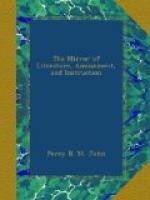W.G.C.
* * * * *
HERSCHEL’S TELESCOPE.
(To the Editor of the Mirror.)
Your correspondent, a Constant Reader, in No. 330 of the MIRROR, is informed that the identical telescope which he mentions is now in the possession of Mr. J. Davies, optician, 101, High-street, Mary-le-bone, where it may be seen in a finished and perfect state. It is reckoned the best and most complete of its size in Europe.
It was ordered to be made for his late majesty George III. as a challenge against the late Dr. Herschel’s; but was prevented from being completed till some time after. The metals, 9-1/4 inches in diameter, having a diagonal eye-piece, four eye tubes of different magnifying powers, and three small specula of various radii, were made by Mr. Watson.
J.D.
* * * * *
ANCIENT ROMAN FESTIVALS.
* * * * *
OCTOBER.
(For the Mirror.)
The Augustalia was a festival at Rome, in commemoration of the day on which Augustus returned to Rome, after he had established peace over the different parts of the empire. It was first established in the year of Rome 735.
The Fontinalia, or Fontanalia, was a religious feast, held among the Romans in honour of the deities who presided over fountains or springs. Varro observes, that it was the custom to visit the wells on those days, and to cast crowns into fountains. This festival was observed on the 13th of October.
The Armilustrum was a feast held on the 19th of October, wherein they sacrificed, armed at all points, and with the sound of trumpets. The sacrifice was intended for the expiation of the armies, and the prosperity of the arms of the people of Rome. This feast may be considered as a kind of benediction of arms. It was first observed among the Athenians.
P.T.W.
* * * * *




